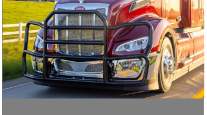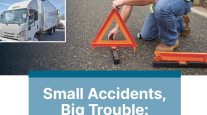Opinion: The First 24 Hours After an Accident
Attorney
Bowman and Brooke LLP
This Opinion piece appears in the April 26 print edition of Transport Topics. Click here to subscribe today.
Any commercial carrier accident involving personal injury or property damage has lawsuit potential, and the public is usually quick to blame the truck driver. For fleets, however, deliberate, careful, immediate attention following an accident is critical for sorting out who really was at fault and minimizing the financial implications of a lawsuit.
Most large carriers understand and have prepared for it with a detailed accident-response plan. But if you are among the many small- to medium-size trucking companies and owner-operators still unprepared, you need to act now, with the following three action items serving as the backbone of your accident-response plan.
1. Send your attorney to the accident scene immediately, and communicate through him or her.
Don’t participate in a flurry of post-accident e-mails; anything put in writing can come back to haunt you. Sharing comments and immediate impressions only with your attorney may protect them from “discovery” by the plaintiff‘s counsel.
Your driver also should talk with your attorney before saying anything to law enforcement, accident responders, news media or injured motorists.
A truck accident, especially with injuries, can overwhelm the emotions of even the most veteran driver, regardless of fault, and lead him or her to speak without thinking. Dispatched immediately to the scene, your attorney can calm the driver and explain what is and isn’t appropriate to tell law enforcement.
Your attorney also can remind your driver not to give statements to anyone but law enforcement and even provide an official “no comment” response that won’t be the lead item on the evening news.
Having your attorney on scene right away also facilitates a solid, early evaluation of potential liability. The attorney should have 90% of the salient facts within the first 24 hours after the accident and be able to advise you whether to gear up for trial or consider an early settlement.
2. Properly preserve documents and other evidence.
Never destroy documents or evidence, no matter how badly they reflect on your company or driver, because the plaintiff’s counsel can argue that the document said something much worse than it actually did. A bad driving history or incomplete logbook can be explained away, but destroying a critical piece of evidence increases exposure to liability exponentially and may result in civil sanctions or criminal prosecution.
Recent technological developments for commercial truck communications can provide useful documentation. Most carriers now use Global Positioning System receivers and wireless communications systems of varying sophistication. Some have installed electronic onboard recorders without waiting for a government mandate. Data from EOBRs or other devices are useful for matching up logbooks and demonstrating your driver was not fatigued or running behind schedule.
In addition, nearly all tractors today carry an engine control module, or “black box,” that records what the driver was doing in the seconds leading up to an accident, such as speed, braking and other types of data — even extreme turns.
This information, plus the driver’s personnel file and logbooks, removes plaintiff counsel’s ability to plant in the minds of the jury any speculation or doubt about your driver’s efforts to avoid the accident. Even if the data show your driver could have done more to avoid the accident or even caused it, the information still helps your attorney to assess the case.
Because evidence can vanish quickly or be obscured, send an accident reconstruction expert to the scene as soon as possible within the first 24 hours to collect such data as road conditions, skid marks and debris locations.
Because the expert often works side-by-side with law enforcement at the scene, he or she may be able to give you an idea of what’s in the police accident report.
Getting an accident reconstruction expert to the scene immediately also means you and your driver will be less likely to make the big mistake of trying to document the scene yourselves.
Accident reconstruction experts are trained to know what should — or should not — be photographed and documented, how to collect and preserve evidence properly and how to give strong trial testimony likely to hold up in court.
3. Develop a game plan to minimize liability exposure.
Most people don’t realize that earning and keeping a commercial driver license require rigorous training and testing, thorough background checks, medical examinations and regular drug tests. Combined with the negative portrayals of truck drivers by the entertainment and news media, these requirements make defending an accident case difficult.
Your best tool for overcoming this misinformation is to assemble the facts supporting your defense promptly, before they are lost or distorted.
If you don’t have an accident response plan in place, do it today. Start giving drivers regular safety training, including a review of your accident response plan.
If you work with an insurer for accident claims, call today for the names and numbers of an attorney and an accident reconstruction expert prepared to travel to an accident scene anywhere you run trucks, any hour of the day or night. If your insurer handles these contacts, establish a direct 24-hour line to your agent for immediate accident notification.
The first 24 hours can make or break a case: Be prepared.
The author works from the Minneapolis office of trial attorneys Bowman and Brooke LLP. He also is a member of the Defense Research Institute’s Trucking Law Committee.




